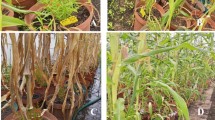Abstract
Lepidopteran stemborers, mainly the African stemborer Busseola fusca Fuller and spotted stemborer Chilo partellus Swinhoe, are among the economically important pests of sorghum in Kenya. Identification of sources of resistance is valuable for the development of an integrated pest management strategy to minimize losses. This study evaluated 27 genotypes with artificial infestations (mostly for tolerance) in two different agroecological zones. Data on damage from leaf feeding, dead heart, exit holes, and stem tunnelling; plant height; days to 50% flowering; total grain yield; and hundred-grain mass were collected. Significant differences (P < 0.001) were observed in all the traits evaluated, except leaf damage, under infestation by C. partellus. Classification into different categories of resistance revealed genetic variation. Genotypes resistant/moderately resistant to both pests were as follows: ICSA 464>ICSB 464>ICSB 467>ICSA 472>ICSB 472>ICSA 473>ICSA 474>IESV 91131 DL>Macia. The relative contributions of the damage parameters to grain yield loss were partitioned into direct and indirect relationships by path coefficient analysis with grain yield as the resultant variable. The results revealed that damage from exit holes, dead heart, leaf feeding and stem tunnelling had a negative indirect effect on grain yield. The identified genotypes can be used to enhance resistance to both pests in susceptible cultivars that farmers prefer.
Similar content being viewed by others
References
Afzal M., Nazir Z., Bashir M. H. and Khan B. S. (2009) Analysis of host plant resistance in some genotypes of maize against Chilo partellus (Swinhoe) (Pyralidae: Lepidoptera). Pakistan Journal of Botany 41, 421–428.
Amsalu D., Bekele J. and Melaku W. (2008) Effect of fertilizer and crop variety on the survival of Busseola fusca (Lepidoptera: Noctuidae) in cereals in Ethiopia. International Journal of Tropical Insect Science 27, 172–182.
Beyene Y., Mugo S., Mutinda C., Tefera T., Karaya H., Ajanga S., Shuma J., Tende R. and Kega V. (2011) Genotype by environment interactions and yield stability of stem borer resistant maize hybrids in Kenya. African Journal of Biotechnology 10, 4752–4758.
De Groote H. (2002) Maize yield losses from stemborers in Kenya. International Journal of Tropical Insect Science 22, 89–96.
Dillon S. L., Shapter F. M., Henry R. J., Cordeiro G., Izquierdo L. and Slade Lee L. (2007) Domestication to crop improvement: genetic resources for Sorghum and Saccharum (Andropogoneae). Annals of Botany 100, 975–989.
Karaya H., Njoroge K., Mugo S. and Nderitu H. (2009) Combining ability among twenty insect resistant maize inbred lines resistant to Chilo partellus and Busseola fusca stem borers. International Journal of Plant Production 3, 115–127.
Kishore Kumar V., Sharma H. C. and Dharma Reddy K. (2006) Antibiosis mechanism of resistance to spotted stem borer, Chilo partellus in sorghum, Sorghum bicolor. Crop Protection 25, 66–72.
Mitchell R. J. (1993) Path analysis: pollination, pp. 211–231. In Design and Analysis of Ecological Experiments (edited by S. M. Scheiner and J. Gurevitch). Chapman & Hall, New York.
Odiyi A. C. (2007) Relationships between stem borer resistance traits and grain yield reduction in maize: correlations, path analysis and correlated response to selection. Agricultural Journal 2, 337–342.
Painter R. H. (1951) Insect Resistance in Crop Plants. MacMillan Co., New York. 520 pp.
Payne R. W., Murray D. A., Harding S. A., Baird D. B. and Soutar D. M. (2009) Genstat for Windows (12th Edition) Introduction. VSN International, Hemel Hempstead.
Piepho H. P., Büchse A. and Truberg B. (2006) On the use of multiple lattice designs and α-designs in plant breeding trials. Plant Breeding 125, 523–528.
Reese J. C., Schwenke J. R., Lamont P. S. and Zehr D. D. (1994) Importance and quantification of plant tolerance in crop pest management programs for aphids: greenbug resistance in sorghum. Journal of Agricultural Entomology 11, 255–270.
Schmidt M. and Bothma G. (2006) Risk assessment for transgenic sorghum in Africa: crop-to-crop gene flow in Sorghum bicolor (L.) Moench. Crop Science 46, 790–798.
Schulz B., Kreps R., Klein D., Gumber R. K. and Melchinger A. E. (1997) Genetic variation among European maize inbreds for resistance to the European corn borer and relation to agronomic traits. Plant Breeding 116, 415–422.
Sharma H. C. (2006) Integrated Pest Management Research at ICRISAT: Present Status and Future Priorities. International Crops Research Institute for the Semi-Arid Tropics, Patancheru. 48 pp.
Sharma H. C., Dhillon M. K. and Pampapathy G. (2006) Multiple-resistance to sorghum shoot fly, spotted stemborer and sugarcane aphid in sorghum. International Journal of Tropical Insect Science 26, 239–245.
Singh B. U., Rao K. V. and Sharma H. C. (2011) Comparison of selection indices to identify sorghum genotypes resistant to the spotted stem borer, Chilo partellus (Swinhoe) (Lepidoptera: Noctuidae). International Journal of Tropical Insect Science 31, 38–51.
Tadele T., Mugo S., Likhayo P. and Beyene Y. (2011) Resistance of three-way cross experimental maize hybrids to post-harvest insect pests, the larger grain borer (Prostephanus truncatus) and maize weevil (Sitophilus zeamais). International Journal of Tropical Insect Science 31, 3–12.
Wale M., Schulthess F., Kairu E. W. and Omwega C. O. (2006) Cereal yield losses caused by lepidopterous stemborers at different nitrogen fertilizer rates in Ethiopia. Journal of Applied Entomology 130, 220–229.
Wortmann C. S., Mamo M., Mburu C., Letayo E., Abebe G., Kayuki K. C., Chisi M., Mativavarira M., Xerinda S. and Ndacyayisenga T. (2009) Atlas of sorghum (Sorghum bicolor L. Moench). Production in East and South Africa. Available at: https://agronomy.unl.edu/ c/document_library/get_file?uuid=dde5a97c-8470-4e77-9dc4-7eddb63263e0&groupId=4128273&.pdf (accessed 16 September 2014).
Author information
Authors and Affiliations
Corresponding author
Rights and permissions
About this article
Cite this article
Muturi, P.W., Mgonja, M. & Rubaihayo, P. Identification of new sorghum genotypes resistant to the African and spotted stemborers. Int J Trop Insect Sci 34, 260–268 (2014). https://doi.org/10.1017/S1742758414000459
Received:
Published:
Issue Date:
DOI: https://doi.org/10.1017/S1742758414000459




